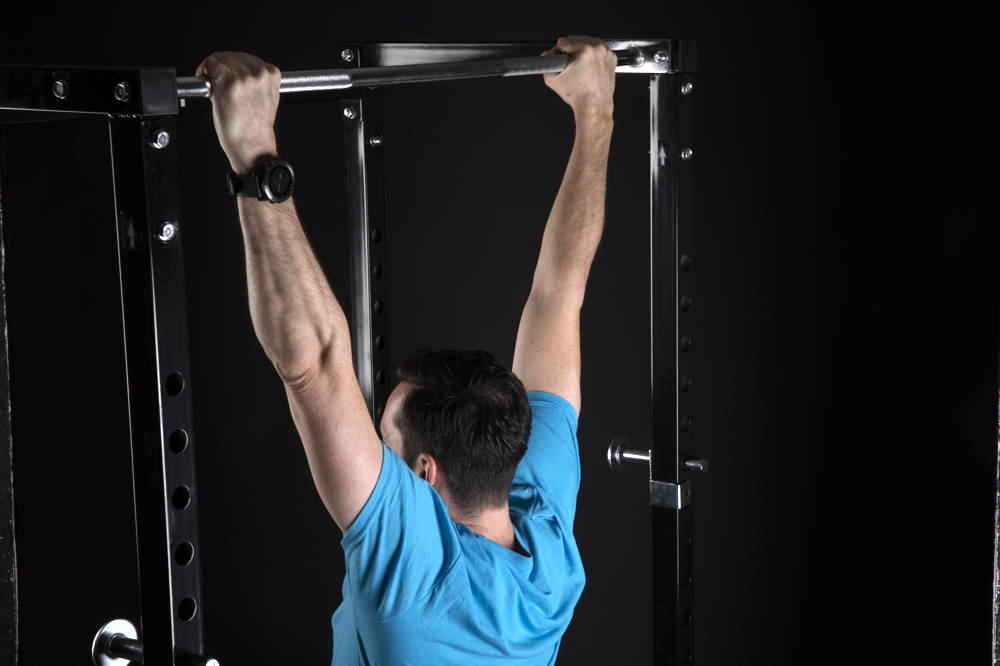Struggling to hold on? Pull-ups are a great way to improve bar grip and back strength
Not only will pull-ups help increase your ability to hold on, they will dramatically improve your riding in other ways too, when incorporated into a mountain bike fitness program.
>>> Get fit for riding: squats
Riding mountain bikes puts a high demand on your grip and forearm strength, where fatigue can quickly lead to a lack of bike control and crippling arm-pump. Riding with a lighter, more relaxed grip on the handlebars can certainly help mitigate this, but there’s really no substitute for boosting your grip strength.
Pull-ups are hands down the best exercise for strengthening the latissimus dorsi, or lats as they are commonly know. These huge muscles on your back run from your armpit to the base of your spine and are primarily responsible for torso rotation and shoulder stability.
Learning to engage your lats effectively through training, the pull-up will enable you to hold a more solid position on the bike for longer, which in turn will take some of the demands away from the smaller muscles in your arms and shoulders.
So the combined benefits of arm and back strengthening with pull-ups can’t be overlooked, and when you factor in the direct affect on your grip strength, pull-ups have incredible crossover to the demands of riding. Best of all, you only need a pull-up bar to start reaping the benefits.


Level: 1: Ring-rows
If you can’t perform a single pull-up yet then don’t fret, ring-rows are a great place to start. To perform a ring-row, engage your core, pull your shoulder blades back and down, just like at the beginning of the strict pull-up, and pull the rings to your chest. Your torso should remain ridged throughout, so don’t let your bum drop down.
Rows are super easy to scale, because the more horizontal your body position, the harder the exercise becomes. The carry over to riding is also excellent as the plane of motion directly mirrors the pulling action on the handlebar.


Level 2: Band-assisted pull-up
Use exactly the same principals outlined for the strict pull-up, but loop a band over the bar and around your foot or knee to assist with the exercise. Bands vary in thickness and strength, so choose one that just allows you to get your chin over the bar for sets of 10 reps. As your chin-up strength improves, use lighter bands until you can do strict pull-ups. A word of warning though, make sure your foot, or knee, holds the band securely in place, because if it slips, it’s going to hurt.


Strict pull-up
Take a double overhand grip, as it better replicates the hand position you adopt on the handlebar, and encourages more lat engagement than the underhand grip of a chin-up. Hang from the bar and engage your core, you should have no tension in your arms other than your grip. Now bring your shoulder blades together (scapular retraction: inset pic) so you engage the correct muscles and execute the movement safely and effectively. Pull yourself up while remaining as vertical as possible. If you hinge back instead of pulling straight up you’ll engage the traps (trapezius muscle on the upper back) too much. Remember, we want to focus on the lats. Once your chin is over the bar, return to the starting point under control and repeat. When you can perform perfect sets of five strict pull-ups, you can keep progressing by can adding weight, either by using a dip belt or simply gripping a medicine ball between your thighs or a dumbbell between your feet.
The coach

Jonny Thompson is head coach for Fit4Racing, an online fitness programme for mtb riders. Once a forensic scientist, Jonny has devoted the last 10 years to coaching athletes from Paralympians to world number one enduro racers. His main focus with the Fit4Racing team is developing and delivering fitness programmes to pro and amateur riders.
Training the likes of Adam Brayton, Jonny also sends digital programmes to riders all over the world, many of whom ride professionally.



